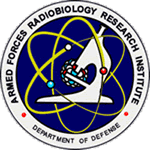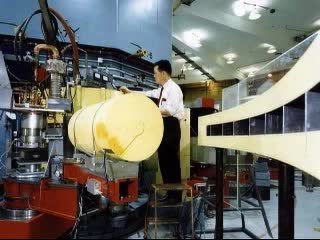
Pacific Northwest National Laboratory (PNNL) is one of the United States Department of Energy national laboratories, managed by the Department of Energy's (DOE) Office of Science. The main campus of the laboratory is in Richland, Washington.
Medical physics deals with the application of the concepts and methods of physics to the prevention, diagnosis and treatment of human diseases with a specific goal of improving human health and well-being. Since 2008, medical physics has been included as a health profession according to International Standard Classification of Occupation of the International Labour Organization.
Radiation dosimetry in the fields of health physics and radiation protection is the measurement, calculation and assessment of the ionizing radiation dose absorbed by an object, usually the human body. This applies both internally, due to ingested or inhaled radioactive substances, or externally due to irradiation by sources of radiation.

Health physics, also referred to as the science of radiation protection, is the profession devoted to protecting people and their environment from potential radiation hazards, while making it possible to enjoy the beneficial uses of radiation. Health physicists normally require a four-year bachelor’s degree and qualifying experience that demonstrates a professional knowledge of the theory and application of radiation protection principles and closely related sciences. Health physicists principally work at facilities where radionuclides or other sources of ionizing radiation are used or produced; these include research, industry, education, medical facilities, nuclear power, military, environmental protection, enforcement of government regulations, and decontamination and decommissioning—the combination of education and experience for health physicists depends on the specific field in which the health physicist is engaged.

Idaho National Laboratory (INL) is one of the national laboratories of the United States Department of Energy and is managed by the Battelle Energy Alliance. Historically, the lab has been involved with nuclear research, although the laboratory does other research as well. Much of current knowledge about how nuclear reactors behave and misbehave was discovered at what is now Idaho National Laboratory. John Grossenbacher, former INL director, said, "The history of nuclear energy for peaceful application has principally been written in Idaho".
Certified Health Physicist is an official title granted by the American Board of Health Physics, the certification board for health physicists in the United States. A Certified Health Physicist is designated by the letters CHP or DABHP after his or her name.
A medical physicist is a health professional with specialist education and training in the concepts and techniques of applying physics in medicine and competent to practice independently in one or more of the subfields (specialties) of medical physics. A medical physicist plays a fundamental role in applying physics to medicine, but particularly in the diagnosis and treatment of cancer. The scientific and technological progress in medical physics has led to a variety of skills that must be integrated into the role of a medical physicist in order for them to perform their job. The "medical services" provided to patients undergoing diagnostic and therapeutic treatments must, therefore, be the result of different but complementary skills. In general, the medical physicist is responsible for all scientific and technical aspects of imaging, radiation treatment, and radiation safety. It is their occupational role to ensure that medical modalities offered to patients are met with the utmost quality assurance. It is the medical physicist that manage and supervise the efforts of dosimetrists, therapists and technologists in that capacity.
The Oak Ridge Institute for Science and Education (ORISE) is an asset of the U.S. Department of Energy that provides expertise in STEM workforce development, scientific and technical reviews, and the evaluation of radiation exposure and environmental contamination. Located in Oak Ridge, Tennessee, ORISE was established in 1992 to support DOE's mission by prepare the next generation of STEM professionals and by collaborating with the DOE Office of Science and other DOE programs, federal agencies, the scientific community, and industry to address scientific initiatives.
Oak Ridge Associated Universities (ORAU) is a consortium of American universities headquartered in Oak Ridge, Tennessee, with offices in Arvada, Colorado, Cincinnati, Ohio, and staff at other locations across the country.

The Armed Forces Radiobiology Research Institute (AFRRI) is an American triservice research laboratory in Bethesda, Maryland chartered by Congress in 1960 and formally established in 1961. It conducts research in the field of radiobiology and related matters which are essential to the operational and medical support of the U.S. Department of Defense (DoD) and the U.S. military services. AFRRI provides services and performs cooperative research with other federal and civilian agencies and institutions.
John Carroll Taschner was a radiation biophysicist. He was a member of the technical staff in the Environment, Safety and Health Division of Los Alamos National Laboratory where he was involved in radiological transportation accident exercise planning.
The American Society of Radiologic Technologists (ASRT) is a professional membership association that serves medical imaging technologists, radiation therapists, and radiologic science students. The organization, located in Albuquerque, New Mexico provides its members with ongoing education and professional development opportunities.

Atomics International was a division of the North American Aviation company which engaged principally in the early development of nuclear technology and nuclear reactors for both commercial and government applications. Atomics International was responsible for a number of accomplishments relating to nuclear energy: design, construction and operation of the first nuclear reactor in California (1952), the first nuclear reactor to produce power for a commercial power grid in the United States (1957) and the first nuclear reactor launched into outer space by the United States (1965).

Radiation dose reconstruction refers to the process of estimating radiation doses that were received by individuals or populations in the past as a result of particular exposure situations of concern. The basic principle of radiation dose reconstruction is to characterize the radiation environment to which individuals have been exposed using available information. In cases where radiation exposures can not be fully characterized based on available data, default values based on reasonable scientific assumptions can be used as substitutes. The extent to which the default values are used depends on the purpose of the reconstruction(s) being undertaken.
Eileen Gail de Planque was an American nuclear physicist. An expert on environmental radiation measurements, she was the first woman and first health physicist to become a Commissioner at the US government's Nuclear Regulatory Commission (NRC). Her technical areas of expertise included environmental radiation, nuclear facilities monitoring, personnel dosimetry, radiation shielding, radiation transport, and solid state dosimetry.

Lauriston S. Taylor was an American physicist known for his work in the field of radiation protection and measurement.

Francis J. Bradley was an American health physicist, writer and founding member of the Health Physics Society.

Dade Moeller was an internationally known expert in radiation safety and environmental protection.
Caridad Borrás is a Spanish medical physicist. Her career started in 1964 at the Santa Creu i Sant Pau Hospital in Barcelona. From 1988 to 2000, she was Regional Advisor of the Radiological Health Program and, from 2000 to 2002, Coordinator of Essential Drugs and Technology at the Pan American Health Organization in Washington D.C.
Geneva Smith Douglas was a nuclear physicist and radiation scientist who worked for both the U.S. Public Health Service and the U.S. Environmental Protection Agency. She served as a scientific collaborator for the nuclear industry and the communities local to her work in researching the impacts of nuclear weapon testing programs at the Nevada Test Site. She developed an offsite radiation monitoring program in her time as the Program Operations Manager of the Environmental Monitoring Systems Laboratory and focused much of her time to speaking and advising on nuclear safety and nuclear testing throughout her career and following her retirement. Douglas was an activist for Soroptimist International and was a charter member of Soroptimist International of Greater Las Vegas. Douglas, with her previous employment and her position within Soroptimist International, lobbied Congress on environmental issues, such as environmental preservation.









